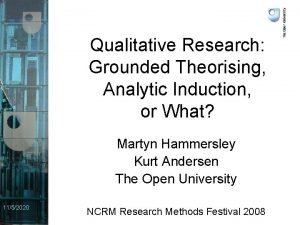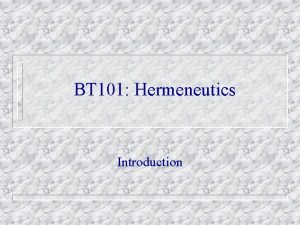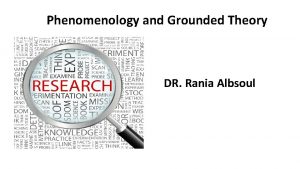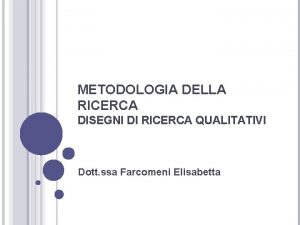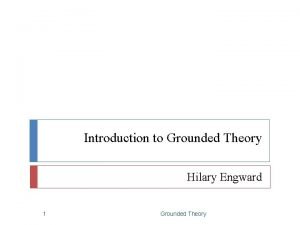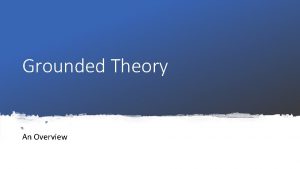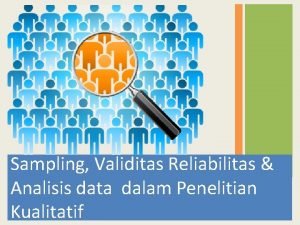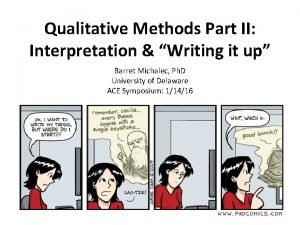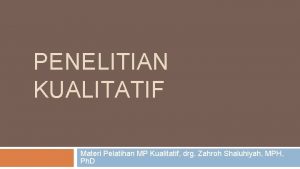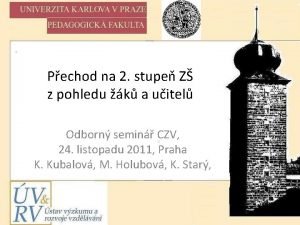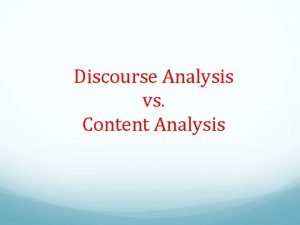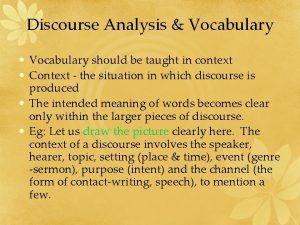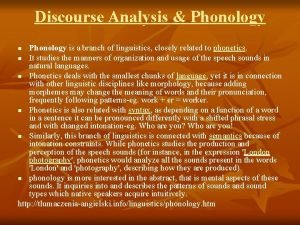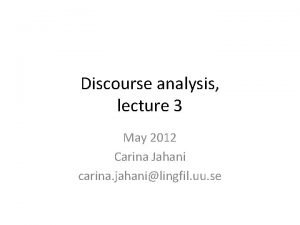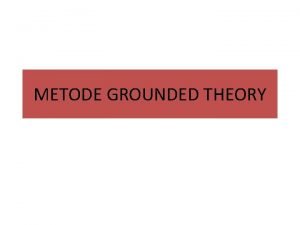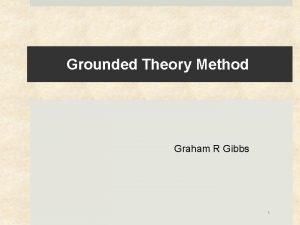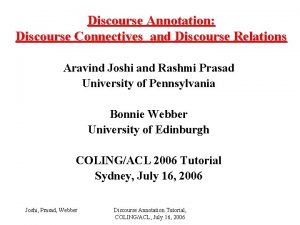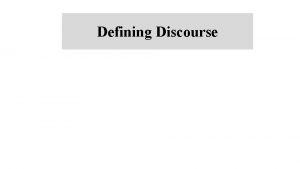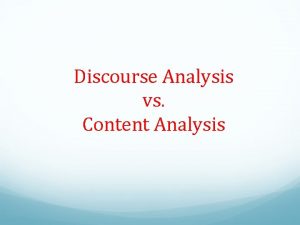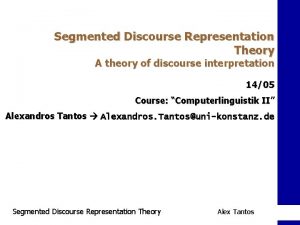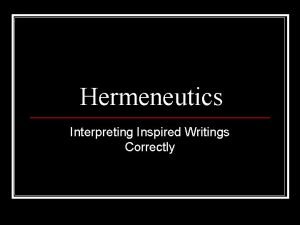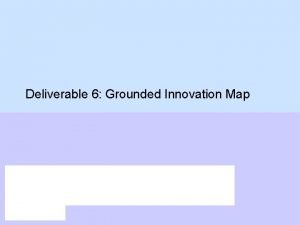Grounded theory discourse analysis and hermeneutics Part One





























- Slides: 29

Grounded theory, discourse analysis and hermeneutics Part One – Grounded Theory ERPM 001 Interpretive Methodologies Dr Alexandra Allan

An outline and some ommissions Aims of the session: To introduce you to the three different approaches: - Their origins, - Key figures in their development, - Underlying principles, - Related methodological techniques - Some examples from the research literature BUT. . . - This is only an introduction, meaning that you will need to conduct some further study following this lecture

Grounded theory: a brief history ‘The Discovery of Grounded Theory’ (1967) Barney Glaser Affiliation: Columbia University Background: Quantitative research Influences: Paul Lazerfield Emphasis: Developing theory ‘Basics of qualitative research’ (1990) Anselm Strauss Juliet Corbin Affiliation: University of Chicago San Jose State Background: Qualitative research Nursing Influences: R. E. Park, G. H. Mead Strauss Emphasis: Going out in the field Process and context

Activity One What is grounded theory? Have you heard about this approach before? No Can you attempt to work out what the terms mean? What do you think is meant by ‘grounded’ and what is meant by ‘theory’? Yes Can you think of a brief definition that would help you to define it and to explain what you know about this approach?

Some definitions Grounded theory is named as such. . . ‘because of its emphasis on the generation of theory and the data in which that theory is grounded’ (Glaser, 1978)

Activity Two ‘The grounded theory approach is a qualitative research method that uses a systematic set of procedures to develop an inductively grounded theory about a phenomenon. The research findings constitute a theoretical formulation of the reality under investigation, rather than consisting of a set of numbers, or a group of loosely related themes. Through this methodology, the concepts and relationships among them are not only generated but they are also provisionally tested. The procedures of the approach are many and rather specific. The purpose of the grounded theory method is, of course, to build theory that is faithful to and illuminates the area under study. Researchers working in this tradition also hope that their theories will ultimately be related to others within their respective disciplines in a cumulative fashion, and that theory’s application will also have useful applications. ’ (Strauss and Corbin 1990: 24)

1) An approach to qualitative data analysis • The development of theory without any particular commitment to a specific theoretical interest • An emphasis on qualitative data analysis and ‘discovery’ (though it has been suggested that statistical analysis could be carried out later) • Common methods include observations and interviews

Not a pick and mix approach! 2) Systematic • A systematic and intensive approach, often involving line by line analysis • Although researchers may ‘pick and choose’ which tasks they use the authors stress that there are no short cuts to developing a well integrated theory • In reality many of the researchers who claim to ‘do’ grounded theory do not. Rather, they use elements of this approach

3) Inductive • Inductive = findings derived from the data • ‘One begins with an area of study and what is relevant is allowed to emerge’ (Strauss and Corbin 1990) • An epistemological fairy tale? OR. . . inductive and deductive/ abductive

4) A set of procedures • A set of distinct procedures • But. . . no ‘hard’ or ‘fixed’ rules, rather they should be used as guidelines • Strauss (1987: 8): ‘Study them, use them, but modify them in accordance with the requirements of your own research’

5) Process • Coterminous data collection (Wiener 2007) • Analysis should begin after the first set of data collection • Constant comparison method • Theoretical sampling

6) Building theory • Not all researchers build theory – many are more concerned with description and weaving their words and their participants’ words into a narrative that represents the social world • Grounded theory is developed from the phenomenon that it represents • A ‘substantive’ or ‘middle-range’ theory

• Theoretical saturation: marks the end of the data collection process when data does not show any new theoretical elements. • Theoretical sensitivity: having theoretical insight and remaining sensitive to theoretical possibilities.

Coding • The way in which we develop and derive concepts from the data Coding Paradigm Conditions Interaction • Not just a process of writing a list of concepts but also asking questions of the data Strategies and tactics Consequences

1) Open coding Unrestricted coding of the data done by scrutinising the field note or interview closely and producing concepts that appear to fit the data Field note Code ‘I am full of grief’ Full of grief ‘I had to try to keep my composure when a patient was yelling by leaving the room’ Professional composure Example taken from Corbin and Strauss 2008

An example. . . Recognising illness spiral Recounting symptom progression Approaching crisis I got sores that are in my mouth, got in my throat and closed my throat up, so I couldn’t eat or drink. And then my potassium dropped down to 2. 0. I was on the verge of cardiac arrest. . . that time when I went in they gave me 72 bottles of pure potassium, burned all my veins out. I asked ‘what does that mean burn all your veins out? ’ Suffering the effects of treatment Receiving rapid treatment Forfeiting comfort for speed She said, ‘It hurts really bad; it’s just because it’s so strong and they can’t dilute it with anything. They said usually what they do is they dilute it with something like a numbing effect, but because I was 2. 0, which is right on cardiac arrest they couldn’t do it, they had to get in fast’. I asked, ‘Did you realise that you were that sick? ’ Example taken from Charmaz 2005

Some handy hints. . . 1) Look for in-vivo codes 2) Give a provisional name for each code 3) Ask a whole battery of questions 4) Pay attention to the coding paradigm 5) Analyse the data minutely 6) Don’t be too committed to the first group of codes (Strauss and Corbin 1992)

2) Axial coding • Connecting the categories revealed during open coding. Data are put back together by making connections between a category and its subcategory • This is done by considering subcategories and their dimensions, properties and characteristics

Paradigm model A) Causal conditions B) Phenomenon C) Context D) Intervening Conditions E) Action/Interaction strategies F) Consequences Causal condition Phenomenon A broken leg Pain Subcategories are linked to a category in a set of relationships using the paradigm model

3) Selective coding • Selective coding builds on the propositions of axial coding and seeks to determine the core category • The core category is effectively the main them of the research, or the concept that all other concepts will be related to Some steps in this process. . . 1) Explicating the story line 2) Relating subsidiary categories to the core category 3) Uncovering patterns 4) Systematising, solidifying and grouping categories 5) Validating and laying out theory 6) Make statements of relationships 7) Fill in the gaps

Memo writing These are written records of our analysis: ‘written explorations of ideas about the data, codes, categories and theory’ (Charmaz 2005). Corbin and Strauss’ advice on writing memos: - They will vary in content depending on the research phase They are not usually written on the fieldnotes Each analyst will develop their own style Memos should also be used for creative and imaginative thinking They need to be written regularly during coding Summary memos can also be used to synthesise he content of several memos

Some examples… Example taken from Gordon-Finlayson (2007)

Some examples… Example taken from Gordon-Finlayson (2007)

Some examples… Example taken from Gordon-Finlayson (2007)

Research literature • Glaser and Strauss advocate delaying the literature review until after completing the analysis • Charmaz – the literature review can be conducted after theory has emerged • Corbin (2007): • • • As a source for making comparisons To enhance sensitivity To stimulate questions To suggest areas for theoretical sampling To confirm findings

The grounded theory process Writing the first draft Integrating memos Further theoretical sampling if needed Sorting memos Theoretical sampling Theoretical memo writing and further refining of concepts Advanced memos Data collection – focused coding Initial memos Initial coding/data collection Research problem Adapted from Charmaz 2006

An example study… Taken from Juliet Corbin’s work with pregnant women experiencing chronic illness 1) Interviewing and openly coding the data 2) Return to the field and collect further data 3) Axial coding to explore links between categories 4) Selective coding to find a core category 5) Return to field to test theory 6) Literature review and writ up storyline

An example study… Categories: Risks, risks context, desire for a healthy baby, assessing, balancing, controlling and outcome. Storyline: ‘The main story seems to be about how women with pregnancies complicated by chronic illness manage the risks they perceive to be associated with their pregnancies in order to have a healthy baby’. Core category: Protective governance Concept paradigm: Risk factors associated with pregnancy +chronic illness (Causal condition)= leads to need for protective governing (phenomenon) Assessing (action) leads to definition of risk contexts which modified through: motivation, balancing + other intervening conditions = leads to strategies for controlling the risks = results in risk containment (consequences)

Re-examining grounded theory • An extremely widely cited and acclaimed approach • But often seen as doing qualitative research with a positivist stamp of approval • Revisions: • Charmaz – pragmatist underpinnings, • Seale – not a naïve realist epistemology, • Clarke – integrate postmodern sensibilities • E. g. A Constructivist approach (Charmaz 2005): • does not assume that impartial observers enter the research scene without an interpretative frame of reference, • what researchers see depends on their prior interpretative frames. • Conceptual categories arise out of interpretations of the data rather than emanating from methodological practices. • A revision of criteria (credibility, originality, resonance and usefulness. NOT: fit, workability, relevance and modifiability)
 Discourse analysis in linguistics
Discourse analysis in linguistics Critical race theory tenets
Critical race theory tenets Hermeneutics theory
Hermeneutics theory What is analytic induction in qualitative research
What is analytic induction in qualitative research Hermeneutics quiz
Hermeneutics quiz Hermeneutics 101
Hermeneutics 101 Hermeneutics class
Hermeneutics class Susan gasson
Susan gasson Grounded theory coding
Grounded theory coding What is grounded theory in simple terms
What is grounded theory in simple terms What is grounded theory in simple terms
What is grounded theory in simple terms Grounded theory esempi
Grounded theory esempi Theory method
Theory method Grounded theory ppt
Grounded theory ppt Ethnography qualitative research
Ethnography qualitative research The discovery of grounded theory
The discovery of grounded theory Qualitative research is holistic
Qualitative research is holistic Kathy charmaz constructivist grounded theory
Kathy charmaz constructivist grounded theory Grounded theory adalah
Grounded theory adalah Qualitative research design
Qualitative research design Grounded theory qualitative research
Grounded theory qualitative research Grounded theory adalah
Grounded theory adalah Zakotvená teorie
Zakotvená teorie Discourse analysis and content analysis
Discourse analysis and content analysis One face one voice one habit and two persons
One face one voice one habit and two persons Pragmatic definition in linguistics
Pragmatic definition in linguistics Discourse analysis
Discourse analysis Register and signaling vocabulary
Register and signaling vocabulary Discourse analysis and phonology
Discourse analysis and phonology Foregrounding and backgrounding in discourse analysis
Foregrounding and backgrounding in discourse analysis



